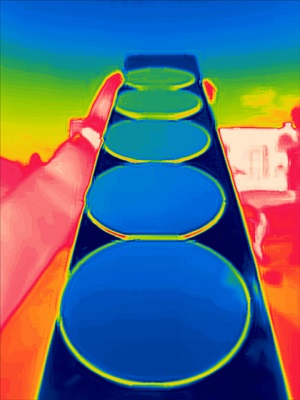Researchers from UCLA have demonstrated a class of optical materials that control how heat radiation is directed from an object. The advance could improve the efficiency of energy conversion systems and enable more effective sensing and detecting technologies.
The work involves a special class of materials that manipulate how thermal radiation travels through such materials, similar to the way that overlapping blinds direct the angle of visible light through a window.

Silicon wafers coated with the gradient ENZ materials viewed through a thermal imaging camera. Courtesy of Raman Laboratory/UCLA.
Previously, a fundamental challenge had prevented materials from directing their heat in specific directions over a broad spectrum to ensure a sufficient amount of heat was emitted. To solve the puzzle, the researchers created a new theoretical framework using nanophotonic materials. To their knowledge, this is the first time broad bands of thermal radiation have been dispersed over predetermined angles in this class of materials.
“To demonstrate this concept, we layered several oxide materials that each manipulate infrared light over different wavelengths, and beamed much of the emitted heat toward the same fixed angles,” said first author Jin Xu, a UCLA materials science and engineering graduate student. “Additionally, the oxides we used are common, so supplies would not be a problem in the production of the material.”
The class of materials the researchers used is known as “epsilon-near-zero” or ENZ materials, and the researchers call the new material a gradient ENZ material. They demonstrated two such material samples that can beam thermal radiation over broad bandwidths to narrow bands of angles — from 60° to 75° to 85°, respectively.
Using a thermal imaging camera, the radiation angles could be seen looking at silicon wafers coated with the gradient ENZ materials. When viewed from most angles, the heated discs appeared cold, similar to how polished metals such as aluminum look under a thermal camera. However, when viewed at one of the designed specific angles, the higher-heat signatures could be spotted on the discs.
“Our goal was to show that we could effectively beam thermal radiation — the heat all objects emanate as electromagnetic waves — over broad wavelengths to the same direction,” said assistant professor of materials science and engineering Aaswath Raman, who led the study. “This advance offers new capabilities for a range of technologies that depend on the ability to control the flows of heat in the form of thermal radiation. This includes imaging and sensing applications that rely on thermal sources or detecting them, as well as energy applications such as solar heating, waste heat recovery, and radiative cooling, where restricting the directionality of heat flow can improve performance.”
The research was published in Science (www.doi.org/10.1126/science.abc5381).